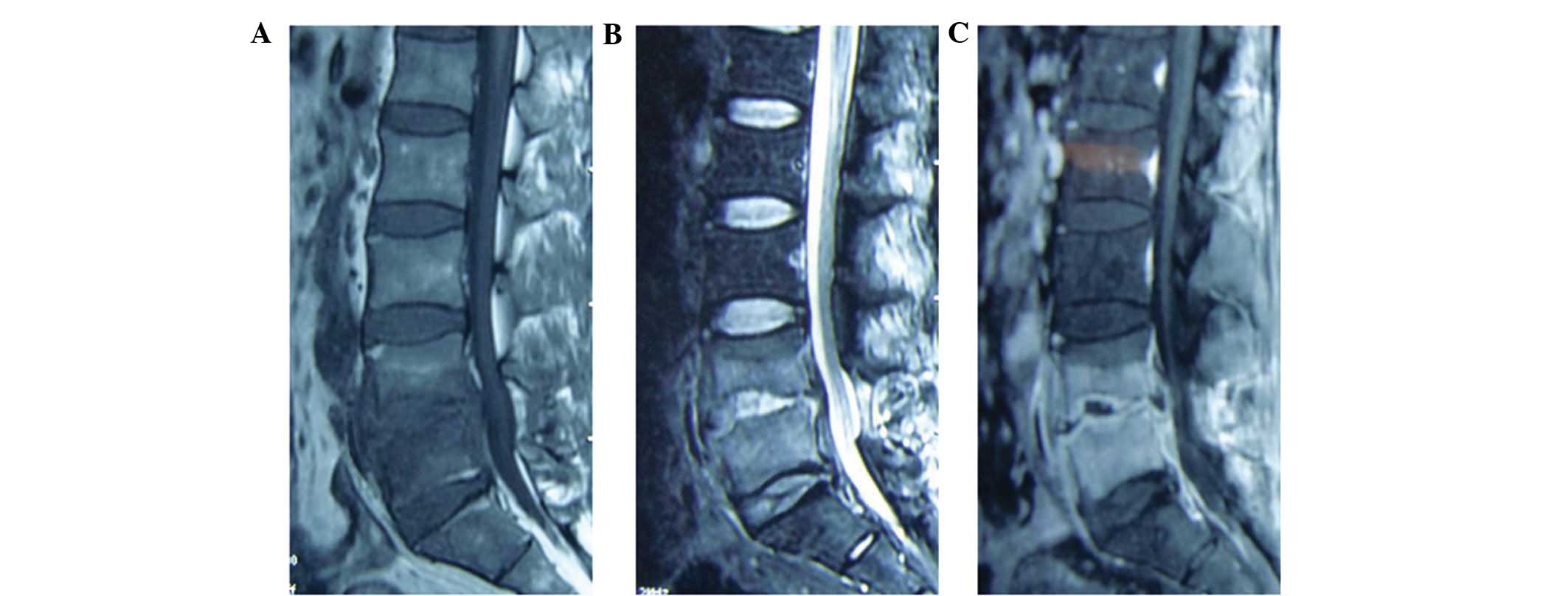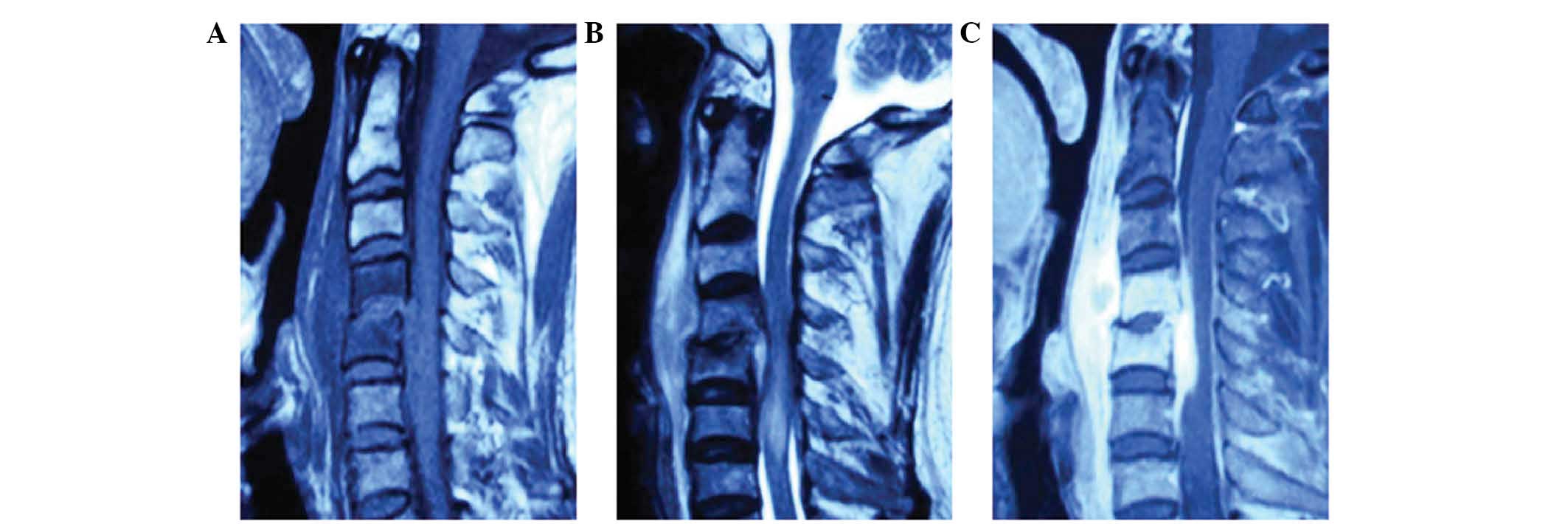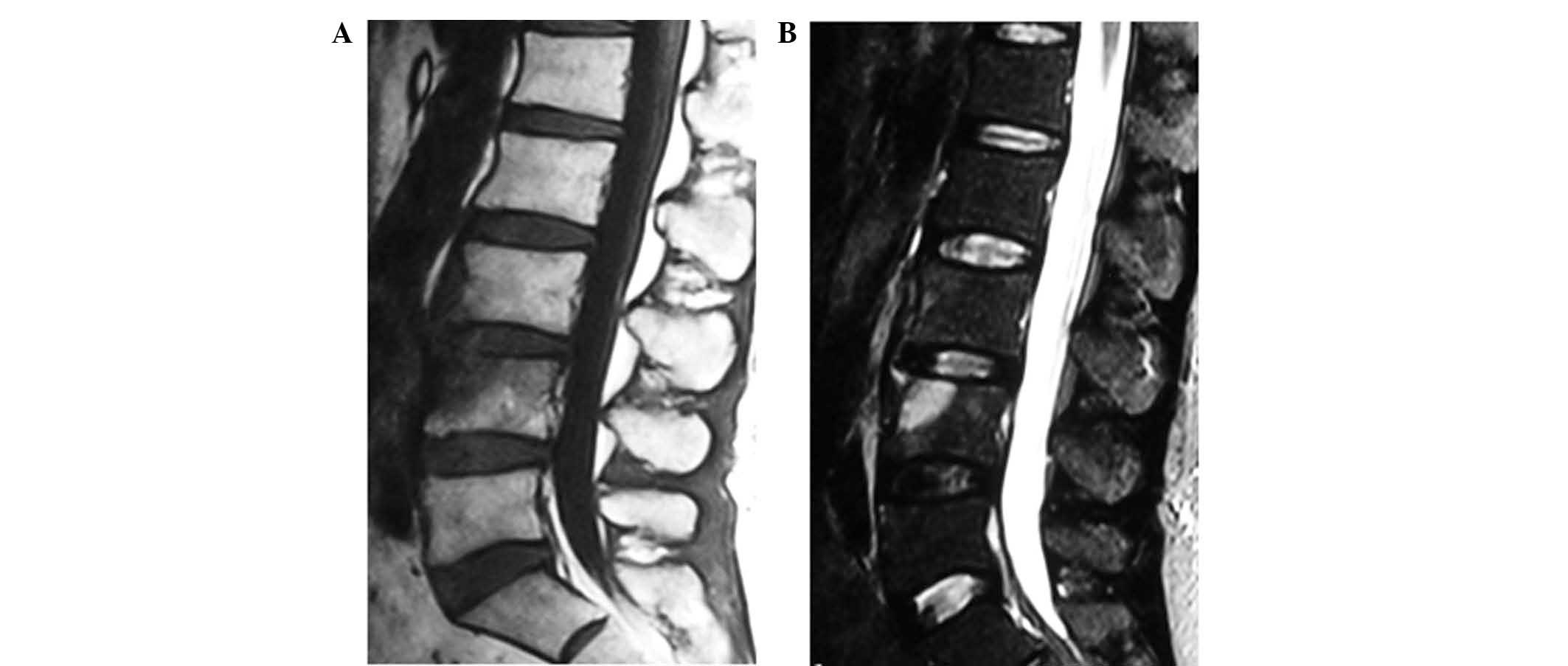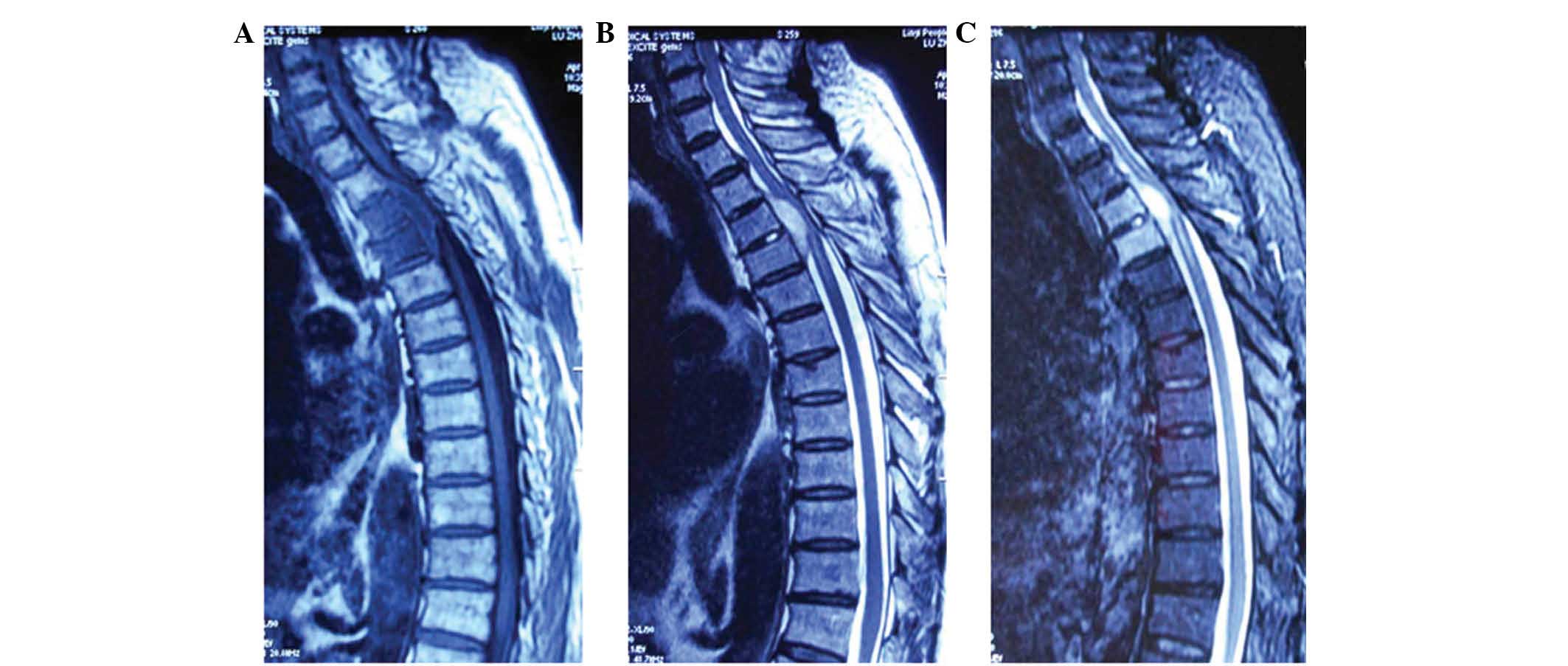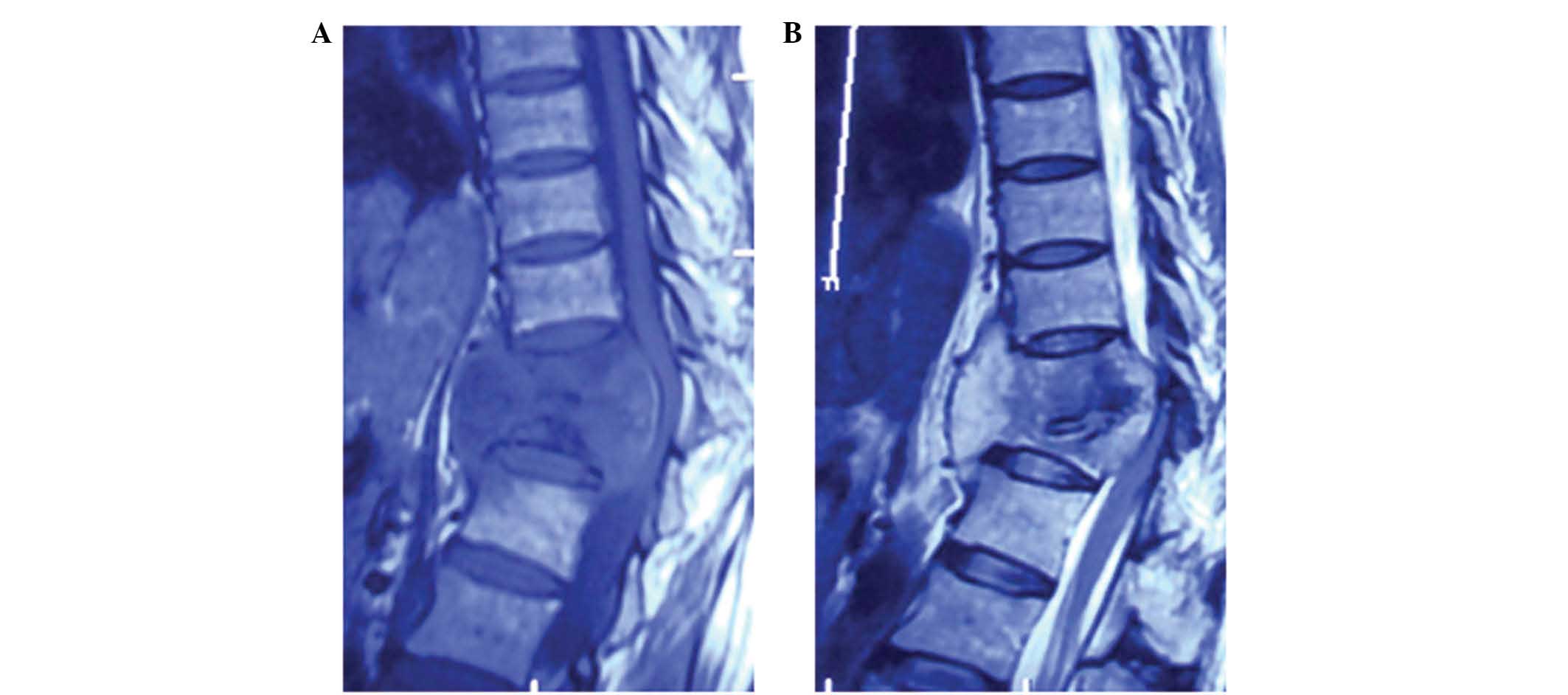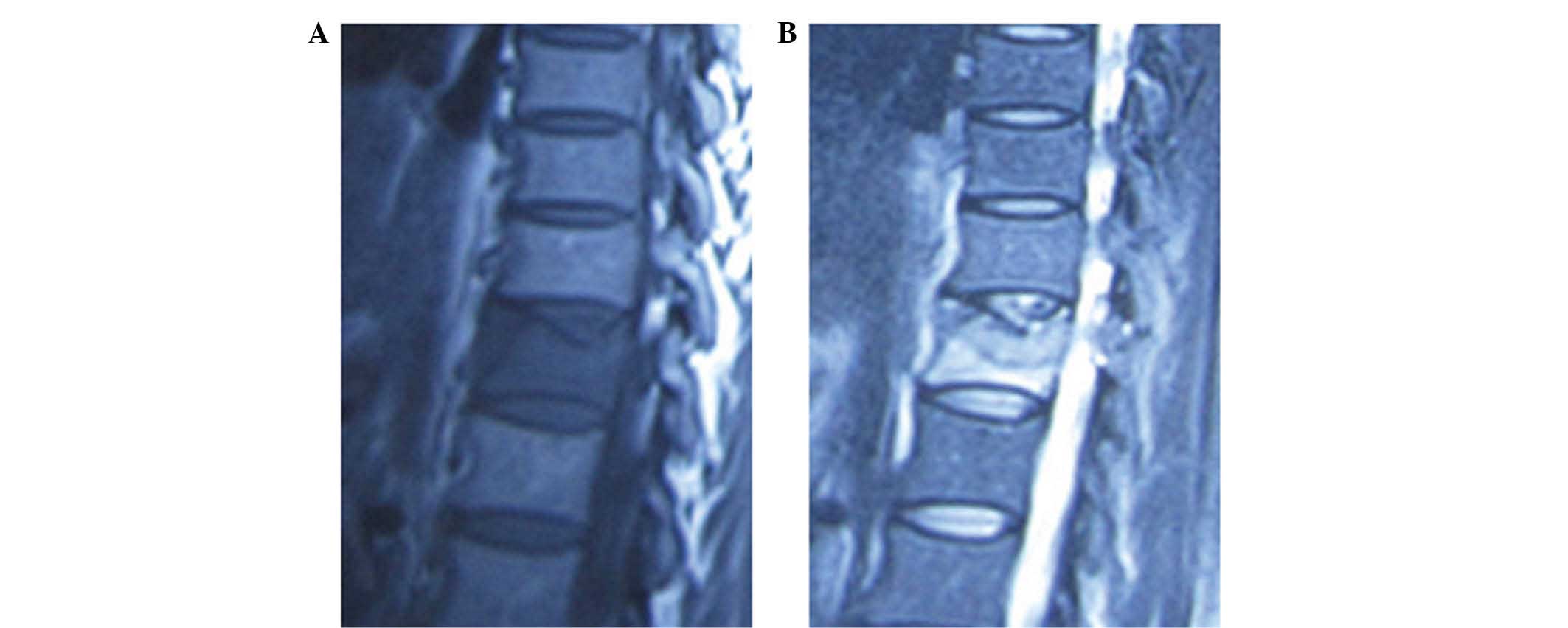|
1
|
Cheung WY and Luk KD: Pyogenic
spondylitis. Int Orthop. 36:397–404. 2012. View Article : Google Scholar : PubMed/NCBI
|
|
2
|
Sapico FL and Montgomerie JZ: Pyogenic
vertebral osteomyelitis: Report of nine cases and review of the
literature. Rev Infect Dis. 1:754–776. 1979. View Article : Google Scholar : PubMed/NCBI
|
|
3
|
Solera J, Lozano E, Martínez-Alfaro E,
Espinosa A, Castillejos ML and Abad L: Brucellar spondylitis:
Review of 35 cases and literature survey. Clin Infect Dis.
29:1440–1449. 1999. View
Article : Google Scholar : PubMed/NCBI
|
|
4
|
Colmenero JD, Cisneros JM, Orjuela DL,
Pachón J, Garcia-Portales R, Rodriguez-Sampedro F and Juarez C:
Clinical course and prognosis of Brucella spondylitis. Infection.
20:38–42. 1992. View Article : Google Scholar : PubMed/NCBI
|
|
5
|
Wang Dali and Zhang Shiyi: Advances in
treatment of acute brucellosis. Zhong Guo Gan Ran Kong Zhi Za Zhi.
16:94–95. 2001.(In Chinese).
|
|
6
|
Shang DQ: Research advances in brucellosis
disease. Zhong Guo Gan Ran Kong Zhi Za Zhi. 19:204–212. 2004.(In
Chinese).
|
|
7
|
Lin C and Liu X: Analysis of brucellosis
infection through diet. Zhong Guo Ren Shou Gong Huan Bing Xue Bao.
17:58–59. 2001.(In Chinese).
|
|
8
|
Koh DM, Bell JR, Burkill GJ, Padley SP and
Healy JC: Mycobacterial infections: Still a millennium bug-the
imaging features of mycobacterial infections. Clin Radiol.
56:535–544. 2001. View Article : Google Scholar : PubMed/NCBI
|
|
9
|
Dye C: Global epidemiology of
tuberculosis. Lancet. 367:938–940. 2006. View Article : Google Scholar : PubMed/NCBI
|
|
10
|
Colmenero JD, Jiménez-Mejías ME,
Sánchez-Lora FJ, Reguera JM, Palomino-Nicás J, Martos F, de las
Heras J García and Pachón J: Pyogenic, tuberculous, and brucellar
vertebral osteomyelitis: a descriptive and comparative study of 219
cases. Ann Rheum Dis. 56:709–715. 1997. View Article : Google Scholar : PubMed/NCBI
|
|
11
|
Yilmaz MH, Mete B, Kantarci F, Ozaras R,
Ozer H, Mert A, Mihmanli I, Ozturk R and Kanbergoglu K:
Tuberculous, brucellar and pyogenic spondylitis: comparison of
magnetic resonance imaging findings and assessment of its value.
South Med J. 100:613–614. 2007. View Article : Google Scholar : PubMed/NCBI
|
|
12
|
Bettini N, Girardo M, Dema E and
Cervellati S: Evaluation of conservative treatment of non specific
spondylodiscitis. Eur Spine J. 18:(Suppl 1). 143–150. 2009.
View Article : Google Scholar : PubMed/NCBI
|
|
13
|
Currie S, Galea-Soler S, Barron D,
Chandramohan M and Groves C: MRI characteristics of tuberculous
spondylitis. Clin Radiol. 66:778–787. 2011. View Article : Google Scholar : PubMed/NCBI
|
|
14
|
Zhao GM, Li F, Sun TS, Wu J, Guan K and
Zhang ZC: Diagnosis and treatment of Brucella spondylitis. Zhong
Guo Ji Zhu Ji Sui Za Zhi. 17:437–439. 2007.(In Chinese).
|
|
15
|
Yee DK, Samartzis D, Wong YW, Luk KD and
Cheung KM: Infective spondylitis in Southern Chinese: A descriptive
and comparative study of ninety-one cases. Spine. 35:635–641. 2010.
View Article : Google Scholar : PubMed/NCBI
|
|
16
|
Fukuda K, Miyamoto H, Uno K and Okada Y:
Indications and limitations of conservative treatment for pyogenic
spondylitis. J Spinal Disord Tech. 27:316–320. 2014. View Article : Google Scholar : PubMed/NCBI
|
|
17
|
Yoon YK, Jo YM, Kwon HH, Yoon HJ, Lee EJ,
Park SY, Pary SY, Choo EJ, Ryu SY, Lee MS, et al: Differential
diagnosis between tuberculous spondylodiscitis and pyogenic
spontaneous spondylodiscitis: A multicenter descriptive and
comparative study. Spine J. 15:1764–1771. 2015. View Article : Google Scholar : PubMed/NCBI
|
|
18
|
Yang X, Shi W, Du YK, Meng XY and Zou YW:
Imaging manifestations and pathological characters of the brucellar
spondylitis. Shi Yong Fang She Xue Za Zhi She. 24:522–525. 2008.(In
Chinese).
|
|
19
|
Duan H, Yang H, Zuo J, Chen G, Zhou L and
He Y: Analysis: Pathology of 6 cases spine tuberculosis. Sheng Wu
Gu Ke Cai Liao Yu Lin Chuang Yan Jiu Za Zhi She. 8:1–3. 2011.(In
Chinese).
|
|
20
|
Li Y and Tang J: Pathology. 6th version.
People's Medical Publishing House; Beijing: 2006, View Article : Google Scholar
|
|
21
|
Zhong X, Chen Z and Huang K: Research
advance on Brucellosis virulence factors and treatment. Xu Mu Yu
Shou Yi. 40:96–101. 2008.(In Chinese).
|
|
22
|
Antunes JL: Infections of the spine. Acta
Neurochir (Wien). 116:179–186. 1992. View Article : Google Scholar : PubMed/NCBI
|
|
23
|
Mete B, Kurt C, Yilmaz MH, Ertan G, Ozaras
R, Mert A, Tabak F and Ozturk R: Vertebral osteomyelitis: Eight
years' experience of 100 cases. Rheumatol Int. 32:3591–3597. 2012.
View Article : Google Scholar : PubMed/NCBI
|
|
24
|
Colmenero JD, Ruiz-Mesa JD, Plata A,
Bermúdez P, Martín-Rico P, Queipo-Ortuño MI and Reguera JM:
Clinical findings, therapeutic approach, and outcome of brucellar
vertebral osteomyelitis. Clin Infect Dis. 46:426–433. 2008.
View Article : Google Scholar : PubMed/NCBI
|
|
25
|
Ariza J, Gudiol F, Valverde J, Pallarés R,
Fernández-Viladrich P, Rufí G, Espadaler L and Fernández-Nogues F:
Brucellar spondylitis: A detailed analysis based on current
findings. Rev Infect Dis. 7:656–664. 1985. View Article : Google Scholar : PubMed/NCBI
|
|
26
|
Glasgow MM: Brucellosis of the spine. Br J
Surg. 63:283–288. 1976. View Article : Google Scholar : PubMed/NCBI
|
|
27
|
Turunc T, Demiroglu YZ, Uncu H, Colakoglu
S and Arslan H: A comparative analysis of tuberculous, brucellar
and pyogenic spontaneous spondylodiscitis patients. J Infect.
55:158–163. 2007. View Article : Google Scholar : PubMed/NCBI
|
|
28
|
Jung NY, Jee WH, Ha KY, Park CK and Byun
JY: Discrimination of tuberculous spondylitis from pyogenic
spondylitis on MRI. Am J Roentgenol. 182:1405–1410. 2004.
View Article : Google Scholar
|
|
29
|
Özaksoy D, Yücesoy K, Yücesoy M,
Kovanlikaya I, Yüce A and Naderi S: Brucellar spondylitis: MRI
findings. Eur Spine J. 10:529–533. 2001. View Article : Google Scholar : PubMed/NCBI
|
|
30
|
Ledermann HP, Schweitzer ME, Morrison WB
and Carrino JA: MR imaging findings in spinal infections: Rules or
myths? Radiology. 228:506–514. 2003. View Article : Google Scholar : PubMed/NCBI
|
|
31
|
Almeida A: Tuberculosis of the spine and
spinal cord. Eur J Radiol. 55:193–201. 2005. View Article : Google Scholar : PubMed/NCBI
|
|
32
|
Zhou J: The early diagnostic value of MRI
on spinal tuberculosis. Zhong Guo Zhong Xi Yi Jie He Ying Xiang Xue
Za Zhi. 4:362–364. 2010.(In Chinese).
|
|
33
|
Çelik AK, Aypak A and Aypak C: Comparative
analysis of tuberculous and brucellar spondylodiscitis. Trop Doct.
41:172–174. 2011. View Article : Google Scholar : PubMed/NCBI
|
|
34
|
Wu W, Liu B, Liu Z, Cui SJ and Guo HB: MRI
in the differential diagnosis of brucella spondylitis and spinal
tuberculosis. Zhong Guo Mei Rong Yi Xue. 21:140–141. 2012.(In
Chinese).
|
|
35
|
Zhou S, Wang J, Zhao X and Fan C: MR
imaging manifestations and staging of pyogenic spondylitis. Ying
Xiang Zhen Duan Yu Jie Ru Fang She Xue. 20:218–221. 2011.(In
Chinese).
|
|
36
|
Yang XM, Shi W, Du YK, Meng XY and Zou YW:
Manifestation of clinical imageology and surgical treatment of the
brucellosis spondylitis. Orthop J Chin. 19:1463–1466. 2007.
|
|
37
|
Hong SH, Kim SM, Ahn JM, Chung HW, Shin MJ
and Kang HS: Tuberculous versus pyogenic arthritis: MR imaging
evaluation. Radiology. 218:848–853. 2001. View Article : Google Scholar : PubMed/NCBI
|
|
38
|
Yang JZ, Wang CJ, He FL, Chen SW and Huang
YF: MR imaging of spondylitis (report of 11 cases). Zhong Guo Yi
Xue Ying Xiang Ji Shu. 15:488–489. 2002.(In Chinese).
|






